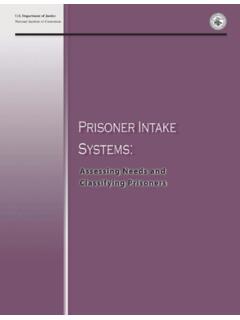Transcription of COGNITIVE-BEHAVIORAL TREATMENT
1 Department of Justice National Institute of Corrections COGNITIVE-BEHAVIORAL TREATMENT A Review and DiscussionA Review and Discussionfor Corrections Professionalsfor Corrections Department of Justice National Institute of Corrections 320 First Street, NW Washington, DC 20534 Morris L. Thigpen Director Thomas J. Beauclair Deputy Director George M. Keiser Chief, Community Corrections/Prisons Division Michael Guevara Project Manager Rachel Mestad Project Manager National Institute of Corrections COGNITIVE-BEHAVIORAL TREATMENT A Review and Discussion for Corrections Professionals Harvey Milkman, Department of Psychology Metropolitan State College of Denver Denver, Colorado Kenneth Wanberg, , Center for Addictions Research and Evaluation (CARE)
2 Arvada, Colorado May 2007 NIC Accession Number 021657 This document was funded by the National Institute of Corrections under cooperative agreement number 06C2020. Points of view or opinions stated in this document are those of the authors and do not necessarily represent the official position or policies of the Department of Justice. The decision to include the six COGNITIVE-BEHAVIORAL TREATMENT programs chosen for this publication was based on a focused literature review of COGNITIVE-BEHAVIORAL treatments for individuals involved in the criminal justice system (see References section of this report).
3 The review showed these to be some of the prominently discussed, imple mented, and researched CBT programs used in correctional settings throughout the United States. These programs are not to be taken as exhaustive of effective CBT treatments for correctional clients, nor are they ranked in any order of impact on recidivism or number of clients served. Contents Foreword.. vii Preface and Acknowledgments .. ix Executive Summary.. xi Chapter 1: The Increasing Need for Effective TREATMENT Services .. 1 Incarceration and Release.. 1 The Need for Mental Health Services.
4 2 Cost-Benefit Analysis .. 2 Focus on Community Reentry .. 3 Chapter 2: What is COGNITIVE-BEHAVIORAL Therapy?.. 5 History and Background.. 5 behavioral Theory .. 5 cognitive Theory .. 6 Blending the Two Theories.. 7 Principles of CBT .. 8 The cognitive Focus of CBT: cognitive Elements and Structures .. 8 The behavioral Focus of CBT: Interpersonal and Social Skills.. 9 The Community Responsibility Focus of CBT: Prosocial Skills Building .. 10 The COGNITIVE-BEHAVIORAL Change Map.. 10 The Counselor s Role .. 12 Personal Characteristics of the Counselor .. 12 Counselor-Client Relationship.
5 12 Correctional Counseling Relationship .. 13 iii Chapter 3: Prominent COGNITIVE-BEHAVIORAL Therapy programs for Offenders .. 15 Aggression Replacement Training .. 16 Social Skills Training .. 16 Anger Control Training.. 17 Moral Reasoning.. 17 Facilitator Training.. 18 Criminal Conduct and Substance Abuse TREATMENT : Strategies for Self-Improvement and Change.. 18 Overview of the TREATMENT Program .. 19 Screening and Assessment .. 20 Facilitator Training.. 21 Moral Reconation Therapy .. 21 Curriculum .. 23 Activities.. 24 Facilitator Training.. 24 Reasoning and Rehabilitation.
6 25 Approach.. 25 R&R2 .. 26 Facilitator Training.. 28 Relapse Prevention Therapy .. 28 Approach.. 28 Facilitator Training.. 30 Thinking for a Change .. 30 Approach.. 30 Facilitator Training.. 31 Chapter 4: Measuring the Effectiveness of Rehabilitation programs .. 35 Recidivism and CBT.. 35 Factors That Determine Effect Size .. 36 Chapter 5: Evaluating Specific CBT Curricula .. 39 Studying the Effectiveness of Aggression Replacement Training .. 39 Studying the Effectiveness of Criminal Conduct and Substance Abuse TREATMENT : Strategies for Self-Improvement and Change.
7 40 Studying the Effectiveness of Moral Reconation Therapy .. 41 Studying the Effectiveness of Reasoning and Rehabilitation.. 44 iv | Contents Studying the Effectiveness of Relapse Prevention Therapy .. 45 Studying the Effectiveness of Thinking for a Change .. 46 Chapter 6: Real World Program Applications .. 49 TREATMENT Dimensions .. 49 Motivation Effects.. 50 Risk Factors.. 50 Role Models and Reinforcers .. 52 Clients With Serious Mental Disorders.. 53 Diversity Considerations.. 54 Strategies To Improve TREATMENT Outcomes.. 55 Appropriate Offender Selection.
8 56 Manualized TREATMENT Curricula .. 56 Conclusions.. 59 References .. 61 Additional Reading .. 73 Exhibits Exhibit 1: SSC Goals and Objectives.. 11 Exhibit 2: The COGNITIVE-BEHAVIORAL Map: The Process of Learning andChange .. 11 Exhibit 3:Overview of Thinking for a Change .. 32 Contents | v Foreword In the latter half of the 20th century, a trend began toward deinstitutionaliza tion of persons with mental illness. At the end of 1988, more than 100,000 patients resided in state and county mental hospitals. By the end of 2000, fewer than 56,000 patients resided in these hospitals, a reduction of almost one-half.
9 An increasing number of these individuals have become involved with the criminal justice system with no indication of a decline in the trend. The Bureau of Justice Statistics estimated that mid-year 1998, there were 283,800 mentally ill offenders in the nation s prisons and jails, representing 7 percent of federal inmates, 16 percent of state prison inmates, and 16 per cent of those in local jails. During those same decades, COGNITIVE-BEHAVIORAL therapy (CBT) emerged as the predominant psychological method of treating not only mental illness, but a broad spectrum of socially problematic behaviors including substance abuse, criminal conduct, and depression.
10 CBT attempts to change negative behaviors by attacking, as it were, from both ends. Clients are not only taught more positive behaviors to replace their old ways of getting through life, they are also shown how to be more attuned to the thought processes that led them to choose negative actions in the past. This publication, COGNITIVE-BEHAVIORAL TREATMENT : A Review and Discussion for Corrections Professionals, offers corrections personnel with various responsibilities an in-depth explanation of what CBT is and how it is being implemented in prisons and jails across the country.















